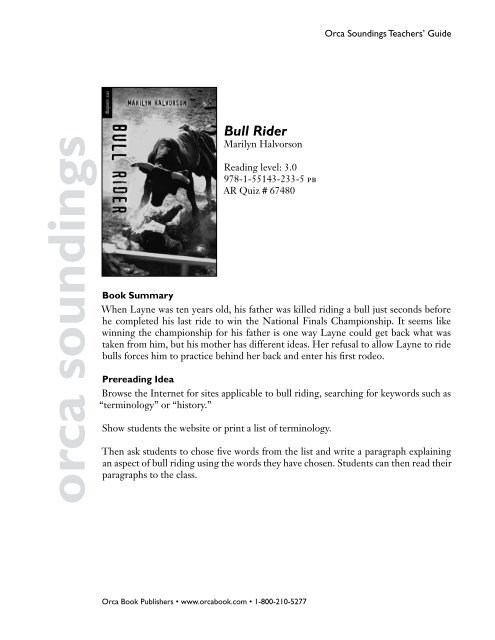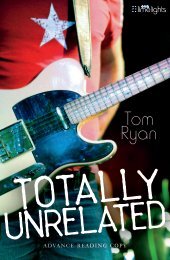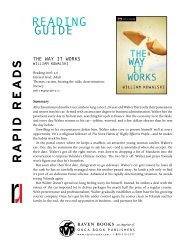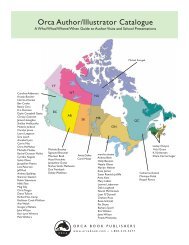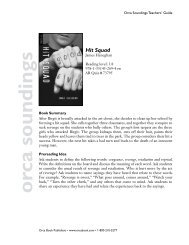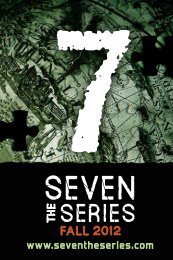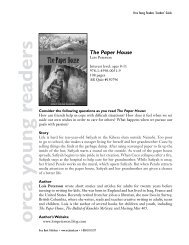orca soundings Bull Rider - Orca Book Publishers
orca soundings Bull Rider - Orca Book Publishers
orca soundings Bull Rider - Orca Book Publishers
You also want an ePaper? Increase the reach of your titles
YUMPU automatically turns print PDFs into web optimized ePapers that Google loves.
<strong>orca</strong> <strong>soundings</strong><br />
<strong>Book</strong> Summary<br />
<strong>Bull</strong> <strong>Rider</strong><br />
Marilyn Halvorson<br />
Reading level: 3.0<br />
978-1-55143-233-5 pb<br />
AR Quiz # 67480<br />
<strong>Orca</strong> <strong>Book</strong> <strong>Publishers</strong> • www.<strong>orca</strong>book.com • 1-800-210-5277<br />
<strong>Orca</strong> Soundings Teachers’ Guide<br />
When Layne was ten years old, his father was killed riding a bull just seconds before<br />
he completed his last ride to win the National Finals Championship. It seems like<br />
winning the championship for his father is one way Layne could get back what was<br />
taken from him, but his mother has different ideas. Her refusal to allow Layne to ride<br />
bulls forces him to practice behind her back and enter his first rodeo.<br />
Prereading Idea<br />
Browse the Internet for sites applicable to bull riding, searching for keywords such as<br />
“terminology” or “history.”<br />
Show students the website or print a list of terminology.<br />
Then ask students to chose five words from the list and write a paragraph explaining<br />
an aspect of bull riding using the words they have chosen. Students can then read their<br />
paragraphs to the class.
<strong>orca</strong> <strong>soundings</strong> Connecting<br />
<strong>Orca</strong> <strong>Book</strong> <strong>Publishers</strong> • www.<strong>orca</strong>book.com • 1-800-210-5277<br />
<strong>Orca</strong> Soundings Teachers’ Guide<br />
to the World—Writing and Research Ideas<br />
• Tara wanted to barrel race; Layne’s heart’s desire was to be a bull rider; Jana’s<br />
father supplied broncs and bulls to the rodeo; and at one time, Chase was the best<br />
bull rider around. Ask students to choose an aspect of rodeo to research: a rodeo<br />
event, rodeo clowns, cowboys, western clothing, animals or others. Have students<br />
assimilate their information and prepare a three to five minute oral presentation<br />
using a visual aid(s). Add an introduction, transitions and organization, as needed,<br />
to tape a documentary on rodeo to share with other classes.<br />
• Layne says that when his dad died, his whole world fell apart; a big hollow space<br />
existed inside of him that nothing would ever fill up. Write a letter to Layne from<br />
his father or from Layne to his father concerning the desire to ride bulls and<br />
the balance between the cost and the thrill of bull riding. Be sure to include the<br />
perspective of the writer on the current situation. Ask students to volunteer to<br />
read their letters to the class.<br />
Connecting to the Text—Elements of the Novel<br />
Theme<br />
The strength of the relationships in Layne’s family proves to be beneficial to Layne. In<br />
groups of three, ask students to brainstorm a list of words that describe the McQueen<br />
family. Beside each word, write the incident that occurred to exemplify that word.<br />
For example, when Terror was willing to risk her life to save Layne from Rhino, she<br />
showed love because she put herself in danger to save her brother. When the groups<br />
have compiled their lists, have them write a thematic statement and a visual depiction<br />
about family relationships. Include the thematic statements and visual depiction on a<br />
class display titled, “Home Sweet Home.”<br />
Conflict<br />
All of the major characters in <strong>Bull</strong> <strong>Rider</strong> face conflict, but the reader sees and feels<br />
Layne’s conflict. In partners, ask students to brainstorm a list of conflicts faced by the<br />
characters and separate them into two columns, internal and external. How do the<br />
characters resolve them? Are the resolutions what you expected? How would you have<br />
handled the situation? Have students role play the conflicts investigating the actual<br />
and alternative resolutions to the conflicts.<br />
Setting<br />
The setting in <strong>Bull</strong> <strong>Rider</strong> makes a strong contribution to the story’s overall impact on<br />
the reader. Ask students to glance back through the novel and find passages, words<br />
and phrases that help create the setting. Ask students to select one passage and draw a<br />
picture of the place described by the author. Place the drawings on a classroom mural<br />
and add written responses to the story alongside the drawings.
<strong>orca</strong> <strong>soundings</strong> Characters<br />
<strong>Orca</strong> <strong>Book</strong> <strong>Publishers</strong> • www.<strong>orca</strong>book.com • 1-800-210-5277<br />
<strong>Orca</strong> Soundings Teachers’ Guide<br />
A character can be classified as static, one who does not change much, or dynamic,<br />
one who changes as a result of the story’s events. List the major characters in <strong>Bull</strong><br />
<strong>Rider</strong> and ask students to identify them as either static or dynamic. Students need to<br />
compare the character in the beginning of the story to the same character at the end<br />
of the story and ask themselves, “Has the character changed, and if so, how did they<br />
change?” Divide students into groups and assign each group a character to chart. Have<br />
students visually portray this character as dynamic or static on a line graph or flow<br />
chart, including events from the story.<br />
Connecting to Students—Discussion Questions<br />
1. Chase remembers what it was like to be a kid, and he says, “You want to do something<br />
so bad, but nobody thinks you are old enough to handle it.” Ask students to share<br />
a time when others felt they were “too young” to accomplish something. Did they<br />
have someone who believed in them and allowed them to do what they wanted to<br />
do? Did they prove to themselves they were capable of handling the situation?<br />
2. Layne knows that riding bulls might cost him his relationship with his mother, but<br />
he is determined to ride. Why does his mother finally give in? What other choices<br />
did she have? What would the consequences have been had she made a different<br />
choice? Have you ever made a decision that could cost you a valuable relationship?<br />
Did it turn out as well as Layne’s decision?<br />
3. For his sister Terror, Layne willingly sacrifices his first ride at the rodeo—with a<br />
surprising result. Why was Layne willing to miss his first ride for her? What does<br />
this tell you about his character? Do you think you would have made the same<br />
choice? Why or why not?<br />
4. The secret Layne was keeping from his mother forced several people to lie for<br />
him. Jana, Chase and Terror all willingly deceived others they loved to help Layne<br />
achieve his dream. Do you think this was right or wrong? Do you think Layne<br />
realized the position in which he put his sister and friends by asking them to cover<br />
for him? Why or why not?<br />
5. Jana and Layne’s relationship begins to change the closer Layne gets to bull riding<br />
in the rodeo. Why do you think their relationship moves from “just friends” to<br />
something more intimate? Do you think it is possible for friends to become<br />
girlfriend and boyfriend? Why or why not?<br />
6. After Rhino almost killed Layne, Layne wanted to ride him to prove he could, but<br />
the thought of it almost made him sick with fear. His desire to overcome that fear<br />
motivated him to face his ride on Rhino with courage and determination. How has<br />
fear motivated you to achieve a goal?
<strong>orca</strong> <strong>soundings</strong> Writer’s<br />
<strong>Orca</strong> <strong>Book</strong> <strong>Publishers</strong> • www.<strong>orca</strong>book.com • 1-800-210-5277<br />
<strong>Orca</strong> Soundings Teachers’ Guide<br />
Craft<br />
Figurative Language<br />
• A simile is a tool writers use to help readers understand a concept by comparing<br />
it to another generally unrelated concept. Students should reread the following<br />
paragraphs, paying close attention to the similes.<br />
…jumping around like he had a hide full of hornets.<br />
…jerked around like a lassoed calf.<br />
…like an eagle’s claw would grab a rabbit.<br />
…tippy-toeing around the barnyard like a ballet dancer.<br />
…paced around like a caged tiger.<br />
Did the author accomplish what she intended? Ask students to write a simile about<br />
an aspect of rodeo on sentence strips and post them around the room.<br />
• When the author uses images that help the reader experience the story with his<br />
or her senses, writing comes alive for the reader. Show students the following<br />
examples, and then have them find some of their own.<br />
…the slippery loose hide over a body full of rippling muscle.<br />
…that bull would have made hamburger out of you.<br />
…he threw me an impatient glance over his shoulder.<br />
…he reared up and pawed the air a couple of times.<br />
…land with a jackhammer jerk and twist.<br />
Do these images and the ones the students found paint them a picture? Have<br />
students write a description of the bull Rhino or Terror’s horse Rambo using<br />
sensory images. Ask students to share their descriptions with the class.<br />
Author Biography<br />
Marilyn Halvorson is not only a writer, but she is a fine horsewoman, raising several<br />
horses and more than fifty Simmental/Hereford cows. When she is not on the ranch,<br />
Marilyn tours schools and talks to students about her books.


